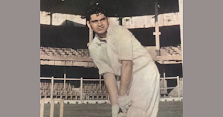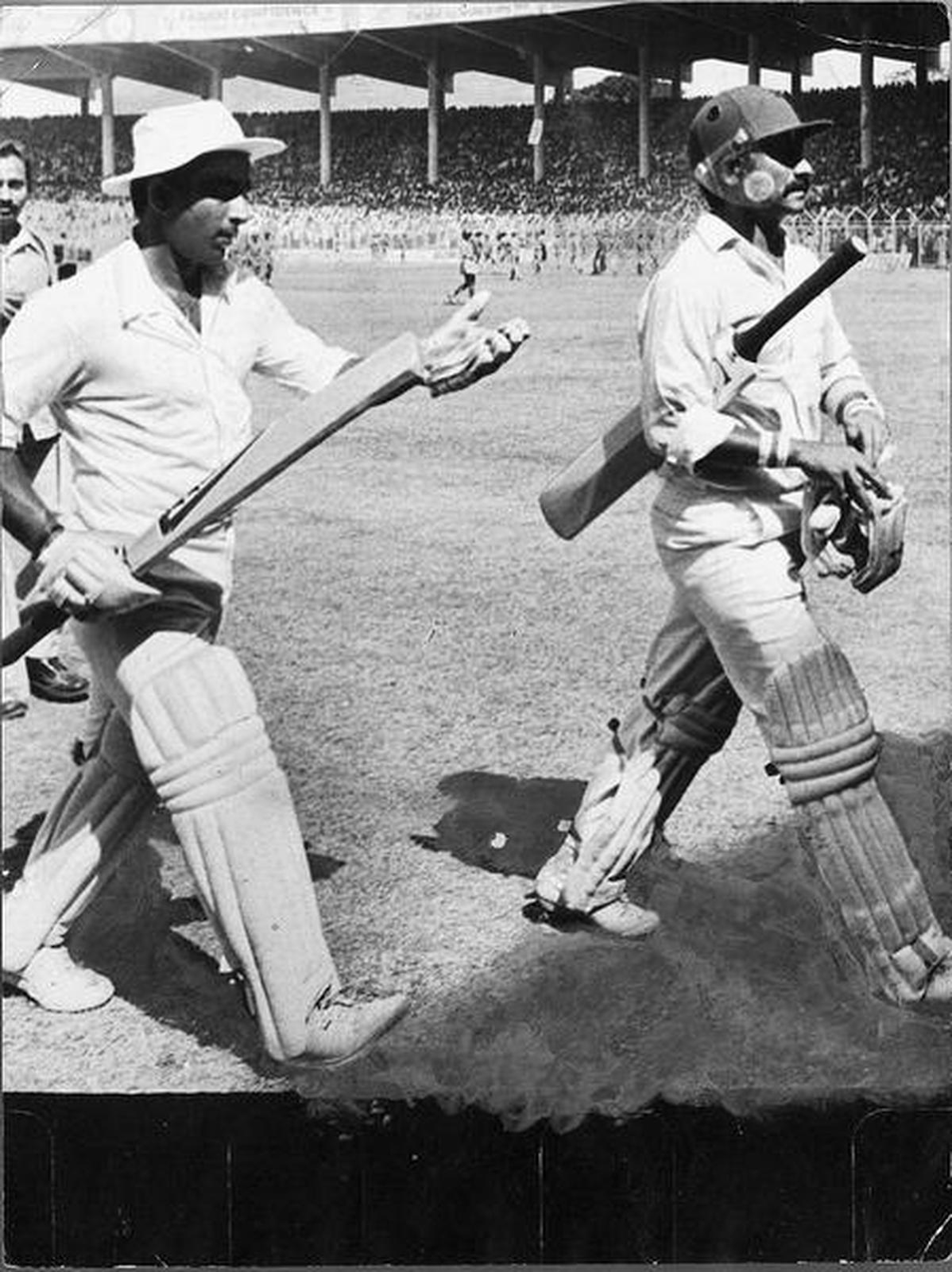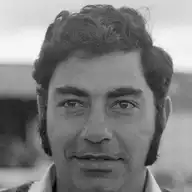Dattu Phadkar
For sheer depth
and variety Dattu Phadkar’s role in Indian cricket is difficult to emulate. On
and off the field he had taken part in every possible drama that is
euphemistically known as Indian cricket.
For the India team he was initially chosen as
a medium fast bowler, but his latent batting potential developed soon enough
for him to be rated as one of leading all-rounders in the country.
Not a bits-and-pieces man, but a genuine
all-rounder in the best sense of the term. Apart from his extraordinary skills
as a player, between mid 1940s and mid 1950s, he also reclined on the
selectorial easy-chair in the 1970s.
Phadkar, born at
Kolhapur in 1925, began playing Ranji Trophy at just 17 for Maharashtra and
later in 1944-45, transferred his allegiance to Mumbai (then Bombay) where his
cricket received the exposure to prosper. Lancashire leagues engagements
occupied his attention for more than a decade in the 1950s.
For Dattu Phadkar cricket was not only a
passion but a profession as well. He was one of the earliest of Indians in the
hard school of Lancashire League, at the time the premier club championship in
England where the professionals from all over the cricket world would
congregate and compete.
Phadkar was a
great success, enjoyed a very high rating in the leagues where the Saturday
afternoon cricket – the forerunner to over-limit cricket of today – required remarkable adaptability and
consistency. The lone pro of every team was required to carry the ten
fellow-amateurs to regular victories. It was no job for the weak-hearted, or
for the half-baked cricketer. And, of course, Phadkar was neither.
In the heydays
of his youth, Phadkar was a fast medium purveyor of swing and seam. He was
nippy and could bowl a bouncer that ruffled batters. When the need arose, he
could use the old ball with a firm clockwise tweak which made the off-cutters
bite and turn. His variety and his control made him an asset to whichever team
he played for during a long and distinguished career.
As a batter he had
a lovely free-flowing style. He drove the ball hard, high and handsome. Never
one to shy away from challenges, Phadkar played the game with courage and
conviction. Athletic of build, every movement of his reeked of natural grace.
Extremely handsome of face and bearing, the debonair presence certainly did
cause quite a flutter among the female followers of the game around the world.
Dattu Phadkar’s
capability would be best exemplified if one cared to study the perspective of
Indian cricket in the 1940s. India was billed to play one of Test cricket’s
greatest-ever sides, Don Bradman’s Australians. India reached Australia in
November 1947, depleted by the absence of Merchant and Mushtaq. Australia won
the 5-Test series, four zero. Bradman, Sidney Barnes, Arthur Morris, Keith Miller
and Raymond Lindwall were just unstoppable.
Apart from Vinoo
Mankad and Vijay Hazare, and to a lesser extent Lala Amamath only in the State
matches, no Indian looked decent enough as a cricketer. This was the series
that pitch-forked Dattu Phadkar into the international arena as a debutant.
And what a debut
it was. He came into the team at Sydney in the 2nd Test match. With 6 wickets
down for a mere 95, the well-built Mumbai man strode in as a Maratha warrior.
He had no desire to go into a defensive shell. That was not in his nature.
Rather he used the bat as a sword and went after the bowlers. In next to no
time the slashing blade scalped 51 notches as India recovered to be all out for
188.
The dream debut
continued with the red cherry in hand. He realized that seaming would not do on
those hard, sun-baked pitches. He concentrated on swing and accuracy and
captured 3 wickets for just 14 runs in 10 overs as Bradman’s team collapsed for
107. Misfortune appeared in the form of continuous rain in the following 3
days, completely ruining the Test. Otherwise there was every likelihood that
Lala Amamath’s Indians would have upset the Australian applecart on the
shoulders of rookie Phadkar.
But, that was
not to be. The following 3 Tests belonged to Australia and they won as they
wished. But among the ruins, along with Mankad and Hazare, young Phadkar kept
his broad chest well thrust out.
In the 3rd Test,
he had Bradman lbw and scored unbeaten 55 and 13. At Adelaide he breezed his
way to a brilliant 123, reducing Miller and Lindwall within human proportions.
Another half century in the final Test concluded that Phadkar was indeed an
exemplary all-rounder.
Such consistency
spelt class. Obviously enough the expectations of the cricket followers went
up. And as with class, the success graph too showed a distinct upward flow.
Following series against Goddard’s West Indies in India in 1948-49 Phadkar played
4 Tests scoring 41 and 5, 74, 48 and 10, and 27 and 37. In the first two Tests
he had just 1 wicket but at Chepauk he dismisssed 7 batsmen and also had a haul
of 6 wickets in the final Test at Mumbai.
Then arrived
Nigel Howard’s England (MCC at the time) in the Indian winter of 1951-52.
Phadkar was very much in his elements in the series, both with the ball as well
as the bat. The high-point was an innings of 115 at Eden Gardens. In the
Chepauk Test where India won her first ever Test match victory, Phadkar with an
excellent innings of 61 gave commendable support to the centurions, Pankaj Roy
and Polly Umrigar.
By now his
position in the national team was firmly established among the nuclei. He deserved
the kudos that came his way, for not only did he have the weight of statistics
in his favour, but also a rare grace that enveloped whatever he did. He was a
crowd favourite. Handsome of bearing and appearance, Dattu Phadkar, looked
every inch the accomplished sportsman that he was.
On the tour of
England in 1952 when Hazare’s India was mercilessly exposed by Alec Bedser and
the young firebrand Freddie Trueman. Dattu Phadkar was among those who returned
with their reputation in tatters. A hard-hit 64 in the first Test was the only
redeeming feature in a series where he had difficulty against pace and
movement. Even his bowling suffered. He bowled no less than 116 overs in the series
but had only 2 wickets to show for his effort.
This performance
of Phadkar was as strange as it was ironical. For he was at the time playing
regularly in the leagues in Lancashire and was well acquainted with the varying
conditions prevailing in England. His modest performances affected the morale
of the team as they had relied highly not only on his ability but also on his
vast knowledge for inspiration and guidance. Apart from skipper Hazare, Vinoo
Mankad and young Vijay Manjrekar it was an eminently forgettable tour for every
other member.
Overlooked
initially against Pakistan at home, he played the last 2 Tests at Chepauk and his
favourite Eden Gardens. Thankfully he found his touch with the ball in hand. At
Chepauk he had 2 dismissals and this was followed up with 5 wickets at Eden
Gardens. A very responsible knock of 51 at Calcutta helped him to book his
ticket for India’s inaugural series on West Indies soil in 1953.
On those hard,
sun-baked wickets, akin to the ones he relished in Australia, Phadkar found the
conditions to his liking. But again neither runs nor wickets came his way.
Failure on the tour of Pakistan in 1954-55 revealed that his cricketing days
were numbered.
He did return to
play for India now and then in the 1950s but it was apparent that he was only a
pale shadow of the magnificent all-rounder that he was. Around this time he was
playing in the Calcutta club leagues as a professional alongside his world-famous
contemporary, Subhash Gupte. Ultimately he settled down at Calcutta with a job
in the Eastern Railway. He represented Bengal from 1954 to 1957 and then
finally played first-class cricket for Indian Railways till 1960.
Dattu Phadkar
played 31 Tests for India scoring 1229 runs at 32.34 per innings with 2
centuries. His Test bowling figures are 62 wickets at 36.83. His first-class
figures read 5377 runs at 36.08 and 466 wickets at 22.04 in a career span of 16
seasons during which apart from playing for his home-state of Maharashtra, he
also served Mumbai, Bengal and Indian Railways.
The transfer of
allegiance to Bengal made him eligible to be the east zone representative in
the national selection committee. In the 1970s, he and Pankaj Roy by a system
of musical chairs occupied this extremely responsible post by turns.
Unfortunately, like Roy, he failed to do justice to the honour that was
bestowed on him. Dattu Phadkar hardly ever watched the east zone players in
action and seemed to have a peculiar notion that only cricketers from the
western region were good enough to play for India!
It is indeed
unfortunate that so many of India’s former star cricketers hardly do justice to
the game after their salad days are over. Very critical of the modern
generation, they rarely tend to follow the current trends and yet they pass
judgements on all and sundry issues. Inevitably their views become irrelevant
and a time comes when their worthy contribution as a player to Indian cricket
comes under grave doubts. Unfortunately Phadkar could not come out of this
cocoon-like approach.
Very surprisingly
Dattu Phadkar could not get any worthwhile employment in his favourite hometown
of Mumbai. He had made Calcutta his home since the 1950s. After retirement, Dattu
Phadkar assisted his wife run an extremely successful kindergarten school in
Calcutta. The family was well entrenched in the eastern metropolis. But
Dattubhai’s heart and soul were in Mumbai.
He never could
find the time and energy to watch the east zone players in action as the
national selector. Not even Duleep Trophy matches and fixtures against visiting
foreign teams. He spoilt his cricketing image unnecessarily through a very
casual approach to the task of a selector.
His selectorial
image shattered his glorious cricketing image. Once he actually selected just 4
bowlers for a one-day match! When asked by the media about who would share the
5th bowler’s slot, he replied, “Why? Are 4 bowlers not enough to
bowl 50 overs?” Even as a selector in the late 1970s, he seemed to have little
clue about the basic requirements of a one-day match!
I for one would prefer to remember Dattatray
Gajanan Phadkar (1925-1985) as the handsome, gifted, courageous all-rounder who
did the nation proud with his heroics on the playing arena.









